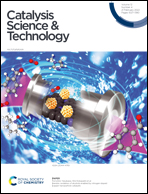In situ FTIR spectroscopy to unravel the bifunctional nature of aromatics hydrogenation synergy on zeolite/metal catalysts†
Abstract
Acid sites, in particular Brønsted sites, are often reported to enhance the catalytic performance of metal catalysts, like platinum, in hydrogenation. The significant boost in catalytic performance suggests that a bifunctional mechanism takes place under such conditions. Therefore, aiming to unravel the mechanism behind the synergy effect in the hydrogenation reaction observed on bifunctional zeolite/metal catalysts, the hydrogenation of pyridine adsorbed on *BEA (HBEA) and γ-Al2O3 (Al2O3 – A) promoted by platinum at low pressure, i.e., P ≤ 150 mbar was investigated. The hydrogenation reaction was followed by FTIR spectroscopy aiming to identify the different phenomena linked to pyridine coordinated on Lewis (PyL) and protonated on Brønsted sites (PyH+), the formation of the reaction products, and modifications on the catalyst. Three series of catalysts with different levels of intimacy between the active sites, an important parameter for bifunctional reactions, were used: PtHBEA < PtA + HBEA < PtA|HBEA ≈ PtAl2O3 ≈ ∞. The experimental results indicate a link between the enhanced hydrogenation activity and the intimacy between zeolites acid sites and the metal sites. The lack of desorption of pyridine and piperidine from HBEA during the reaction clearly indicates that the diffusing hydrogen species, i.e., HSP, are responsible for the conversion of pyridine adsorbed on HBEA acid sites. Indeed, a larger diffusion length between Pt and zeolite led to a slower conversion of the adsorbed pyridine, indicating that a bifunctional mechanism is at play. Hence, when the zeolite and metal are in close proximity a hydrogenation mechanism, complementary to the standard metal hydride and involving HSP and an adsorbed unsaturated molecule, occurs leading to an enhanced catalytic performance.

- This article is part of the themed collection: In situ and operando spectroscopy in catalysis


 Please wait while we load your content...
Please wait while we load your content...